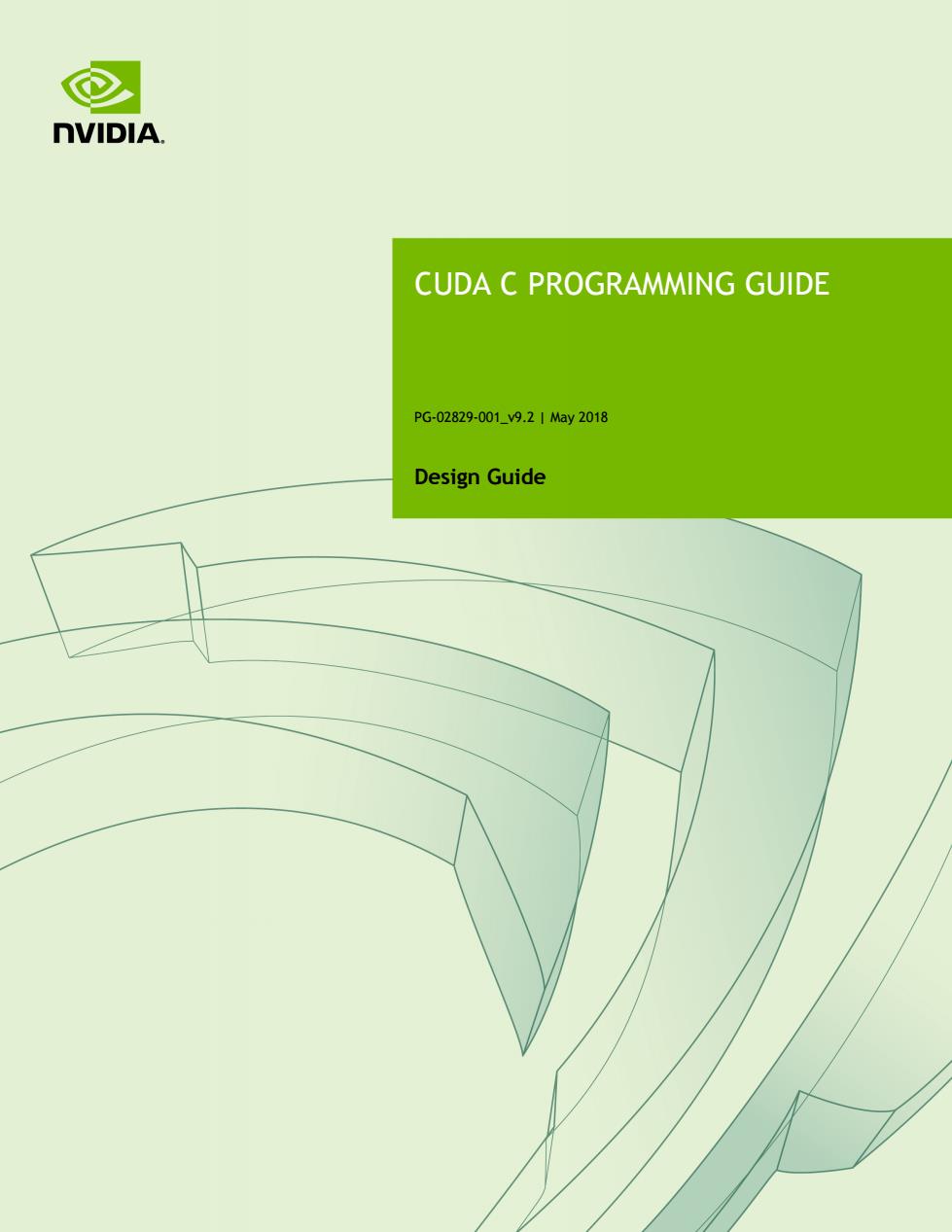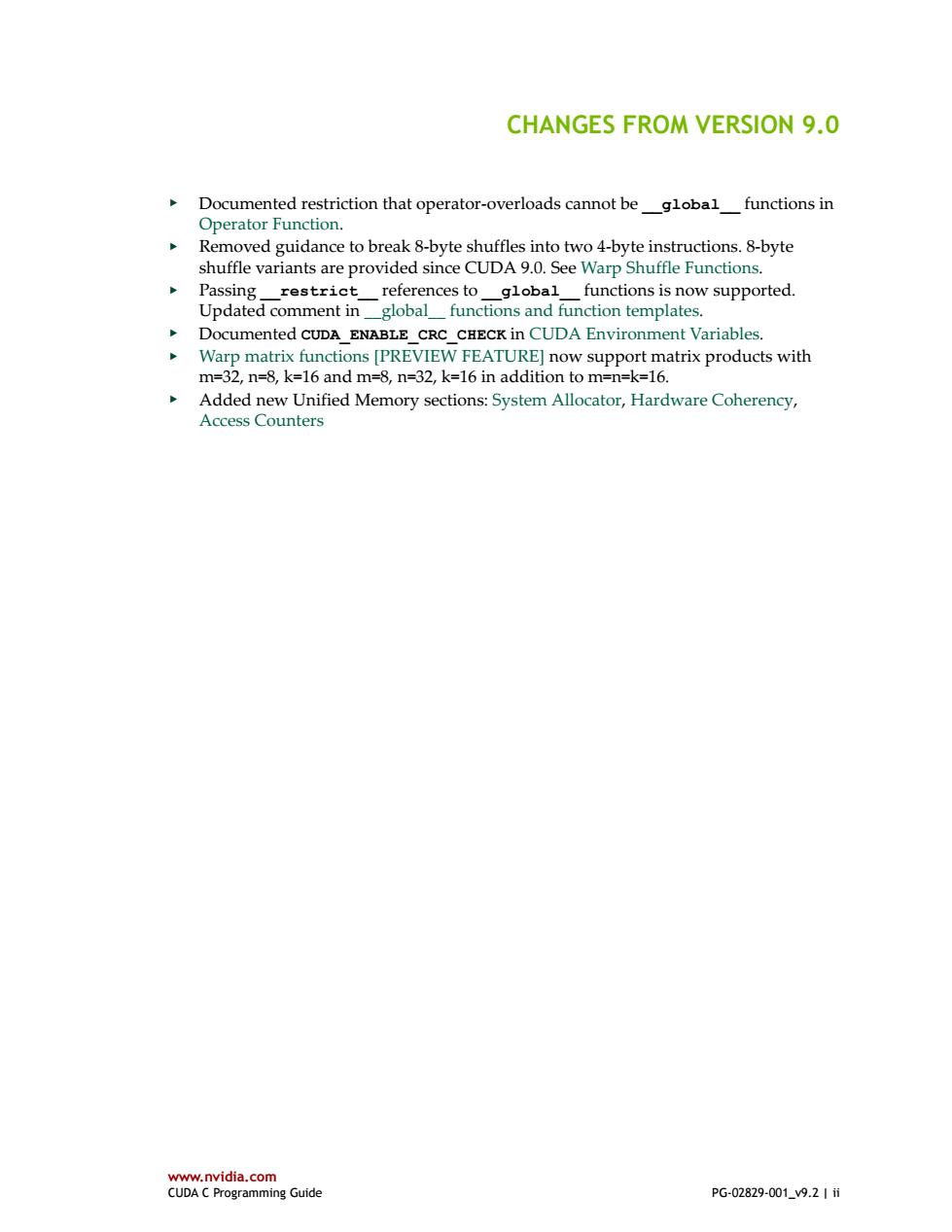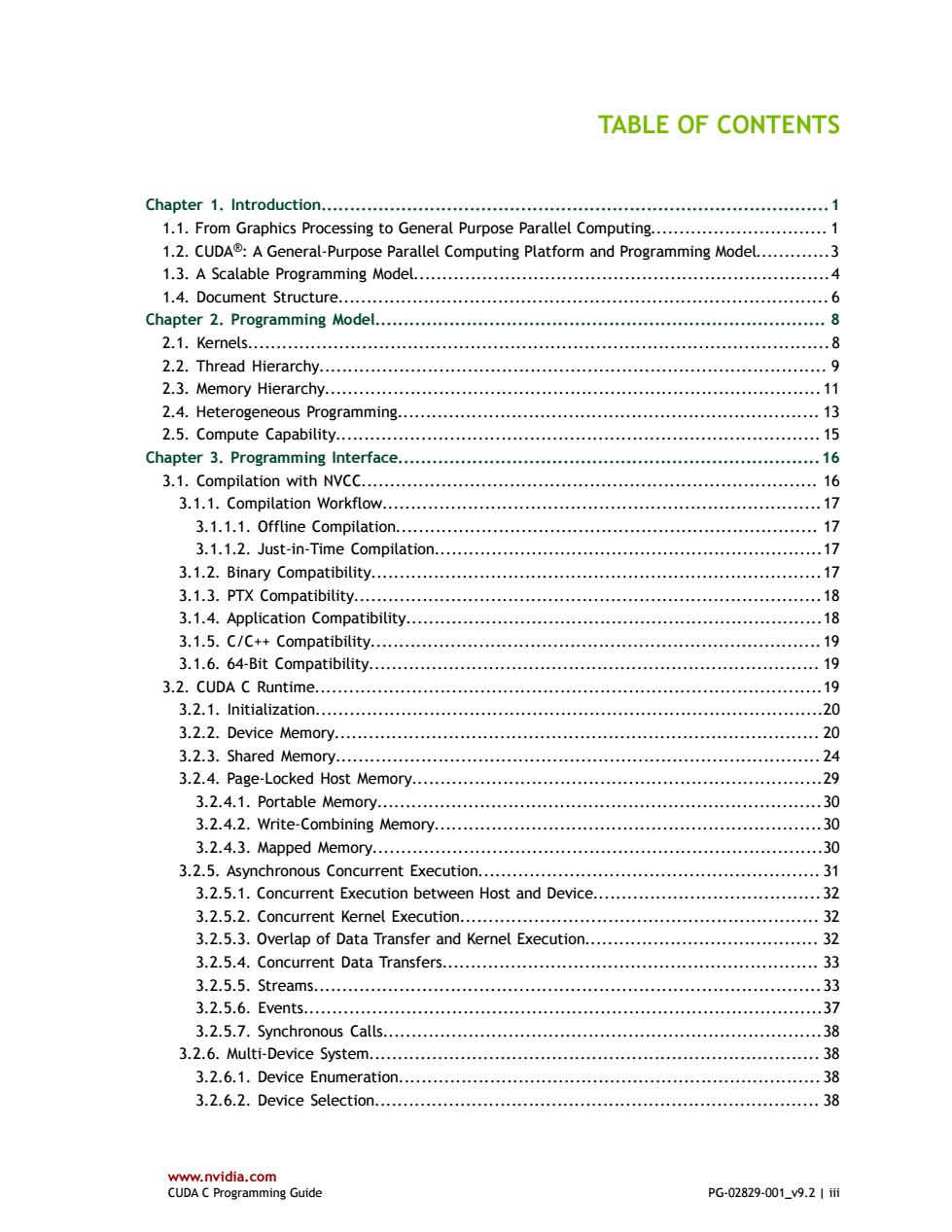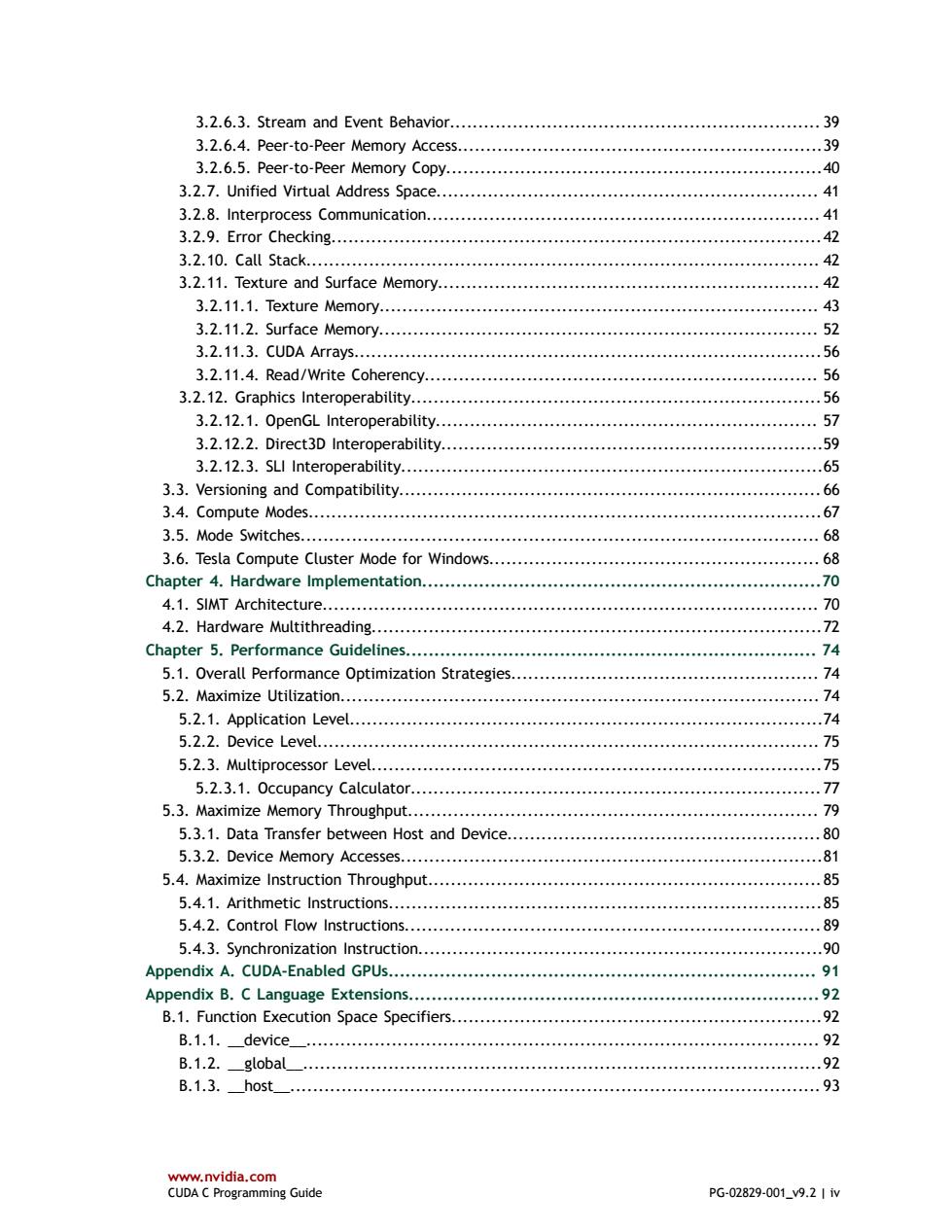
nVIDIA. CUDA C PROGRAMMING GUIDE PG-02829-001v9.2|May2018 Design Guide
CUDA C PROGRAMMING GUIDE PG-02829-001_v9.2 | May 2018 Design Guide

CHANGES FROM VERSION 9.0 Documented restriction that operator-overloads cannot be global functions in Operator Function. Removed guidance to break 8-byte shuffles into two 4-byte instructions.8-byte shuffle variants are provided since CUDA 9.0.See Warp Shuffle Functions. Passing restrict references to global functions is now supported. Updated comment in globalfunctions and function templates. Documented CUDA ENABLE CRC CHECK in CUDA Environment Variables. Warp matrix functions [PREVIEW FEATURE]now support matrix products with m=32,n=8,k=16 and m=8,n=32,k=16 in addition to m=n=k=16. Added new Unified Memory sections:System Allocator,Hardware Coherency, Access Counters www.nvidia.com CUDA C Programming Guide PG-02829-001v9.21ii
www.nvidia.com CUDA C Programming Guide PG-02829-001_v9.2 | ii CHANGES FROM VERSION 9.0 ‣ Documented restriction that operator-overloads cannot be __global__ functions in Operator Function. ‣ Removed guidance to break 8-byte shuffles into two 4-byte instructions. 8-byte shuffle variants are provided since CUDA 9.0. See Warp Shuffle Functions. ‣ Passing __restrict__ references to __global__ functions is now supported. Updated comment in __global__ functions and function templates. ‣ Documented CUDA_ENABLE_CRC_CHECK in CUDA Environment Variables. ‣ Warp matrix functions [PREVIEW FEATURE] now support matrix products with m=32, n=8, k=16 and m=8, n=32, k=16 in addition to m=n=k=16. ‣ Added new Unified Memory sections: System Allocator, Hardware Coherency, Access Counters

TABLE OF CONTENTS Chapter 1.Introduction..1 1.1.From Graphics Processing to General Purpose Parallel Computing...............................1 1.2.CUDA:A General-Purpose Parallel Computing Platform and Programming Model.............3 1.3.A Scalable Programming Model.....................................4 1.4.Document Structure....................... 6 8 Chapter 2.Programming Model................ 2.1.Kernets............. .8 2.2.Thread Hierarchy........................... 9 2.3.Memory Hierarchy................... .11 2.4.Heterogeneous Programming.................. 3 2.5.Compute Capability.............. 15 Chapter 3.Programming Interface........ …16 3.1.Compilation with NVCC............ 16 3.1.1.Compilation Workflow.... .17 3.1.1.1.Offline Compilation....... 17 3.1.1.2.Just-in-Time Compilation.. .17 3.1.2.Binary Compatibility............. .17 3.1.3.PTX Compatibility............... 18 3.1.4.Application Compatibility........... 18 3.1.5.C/C++Compatibility...... .19 3.1.6.64-Bit Compatibility............... 19 3.2.CUDA C Runtime.… .19 3.2.1.Initiatization.................... …20 3.2.2.Device Memory.… 20 3.2.3.Shared Memory.................. .24 3.2.4.Page-Locked Host Memory..................... 29 3.2.4.1.Portable Memory.................... .30 3.2.4.2.Write-combining Memory.......30 3.2.4.3.Mapped Memory.................. 30 3.2.5.Asynchronous Concurrent Execution............... .31 3.2.5.1.Concurrent Execution between Host and Device..... .32 3.2.5.2.Concurrent Kernel Execution......................... .32 3.2.5.3.Overlap of Data Transfer and Kernel Execution.... 32 3.2.5.4.Concurrent Data Transfers...................... 33 3.2.5.5.Streams....... .33 3.2.5.6.Events.… 37 3.2.5.7.Synchronous Calls.... .38 3.2.6.Multi-Device System...................... .38 3.2.6.1.Device Enumeration...... .38 3.2.6.2.Device Selection..................38 www.nvidia.com CUDA C Programming Guide PG-02829-001_v9.2|ii
www.nvidia.com CUDA C Programming Guide PG-02829-001_v9.2 | iii TABLE OF CONTENTS Chapter 1. Introduction.........................................................................................1 1.1. From Graphics Processing to General Purpose Parallel Computing............................... 1 1.2. CUDA®: A General-Purpose Parallel Computing Platform and Programming Model.............3 1.3. A Scalable Programming Model.........................................................................4 1.4. Document Structure...................................................................................... 6 Chapter 2. Programming Model............................................................................... 8 2.1. Kernels......................................................................................................8 2.2. Thread Hierarchy......................................................................................... 9 2.3. Memory Hierarchy....................................................................................... 11 2.4. Heterogeneous Programming.......................................................................... 13 2.5. Compute Capability..................................................................................... 15 Chapter 3. Programming Interface..........................................................................16 3.1. Compilation with NVCC................................................................................ 16 3.1.1. Compilation Workflow.............................................................................17 3.1.1.1. Offline Compilation.......................................................................... 17 3.1.1.2. Just-in-Time Compilation....................................................................17 3.1.2. Binary Compatibility...............................................................................17 3.1.3. PTX Compatibility..................................................................................18 3.1.4. Application Compatibility.........................................................................18 3.1.5. C/C++ Compatibility............................................................................... 19 3.1.6. 64-Bit Compatibility............................................................................... 19 3.2. CUDA C Runtime.........................................................................................19 3.2.1. Initialization.........................................................................................20 3.2.2. Device Memory..................................................................................... 20 3.2.3. Shared Memory..................................................................................... 24 3.2.4. Page-Locked Host Memory........................................................................29 3.2.4.1. Portable Memory..............................................................................30 3.2.4.2. Write-Combining Memory....................................................................30 3.2.4.3. Mapped Memory...............................................................................30 3.2.5. Asynchronous Concurrent Execution............................................................ 31 3.2.5.1. Concurrent Execution between Host and Device........................................32 3.2.5.2. Concurrent Kernel Execution............................................................... 32 3.2.5.3. Overlap of Data Transfer and Kernel Execution......................................... 32 3.2.5.4. Concurrent Data Transfers.................................................................. 33 3.2.5.5. Streams.........................................................................................33 3.2.5.6. Events...........................................................................................37 3.2.5.7. Synchronous Calls.............................................................................38 3.2.6. Multi-Device System............................................................................... 38 3.2.6.1. Device Enumeration.......................................................................... 38 3.2.6.2. Device Selection.............................................................................. 38

3.2.6.3.Stream and Event Behavior..... .39 3.2.6.4.Peer-to-Peer Memory Access.....39 3.2.6.5.Peer-to-Peer Memory Copy............ .40 3.2.7.Unified Virtual Address Space............................. 41 3.2.8.Interprocess Communication...... 41 3.2.9.Error checking..................... …42 3.2.10.Call Stack.… …42 3.2.11.Texture and Surface Memory......... 42 3.2.11.1.Texture Memory................ 43 3.2.11.2.Surface Memory.............. 52 3.2.11.3.CUDA Arrays................ .56 3.2.11.4.Read/Write Coherency..... 56 3.2.12.Graphics Interoperability.......... .56 3.2.12.1.OpenGL Interoperability.... 57 3.2.12.2.Direct3D Interoperability...... .59 3.2.12.3.SLI Interoperability....... 65 3.3.Versioning and Compatibility............... .66 3.4.Compute Modes.................... 67 3.5.Mode Switches...68 3.6.Tesla Compute Cluster Mode for Windows... 68 Chapter 4.Hardware Implementation.................. 0…70 4.1.SIMT Architecture................. 70 4.2.Hardware Multithreading............... .72 Chapter 5.Performance Guidelines................. .74 5.1.Overall Performance Optimization Strategies.. 74 5.2.Maximize Utilization.......................... .74 5.2.1.Application Level.................... .74 5.2.2.Device Level.… .75 5.2.3.Multiprocessor Level...... .75 5.2.3.1.Occupancy Calculator............ .77 5.3.Maximize Memory Throughput...... 79 5.3.1.Data Transfer between Host and Device. 80 5.3.2.Device Memory Accesses............ .81 5.4.Maximize Instruction Throughput............ .85 5.4.1.Arithmetic Instructions......... .85 5.4.2.Control Flow Instructions.............. .89 5.4.3.Synchronization Instruction... .90 Appendix A.CUDA-Enabled GPUs............ …91 Appendix B.C Language Extensions..... .92 B.1.Function Execution Space Specifiers .92 B.1.1.device_ 92 B.1.2.global 92 B.1.3.ho5t. 93 www.nvidia.com CUDA C Programming Guide PG-02829-001_v9.21iV
www.nvidia.com CUDA C Programming Guide PG-02829-001_v9.2 | iv 3.2.6.3. Stream and Event Behavior................................................................. 39 3.2.6.4. Peer-to-Peer Memory Access................................................................39 3.2.6.5. Peer-to-Peer Memory Copy..................................................................40 3.2.7. Unified Virtual Address Space................................................................... 41 3.2.8. Interprocess Communication..................................................................... 41 3.2.9. Error Checking......................................................................................42 3.2.10. Call Stack.......................................................................................... 42 3.2.11. Texture and Surface Memory................................................................... 42 3.2.11.1. Texture Memory............................................................................. 43 3.2.11.2. Surface Memory............................................................................. 52 3.2.11.3. CUDA Arrays..................................................................................56 3.2.11.4. Read/Write Coherency..................................................................... 56 3.2.12. Graphics Interoperability........................................................................56 3.2.12.1. OpenGL Interoperability................................................................... 57 3.2.12.2. Direct3D Interoperability...................................................................59 3.2.12.3. SLI Interoperability..........................................................................65 3.3. Versioning and Compatibility.......................................................................... 66 3.4. Compute Modes..........................................................................................67 3.5. Mode Switches........................................................................................... 68 3.6. Tesla Compute Cluster Mode for Windows.......................................................... 68 Chapter 4. Hardware Implementation......................................................................70 4.1. SIMT Architecture....................................................................................... 70 4.2. Hardware Multithreading...............................................................................72 Chapter 5. Performance Guidelines........................................................................ 74 5.1. Overall Performance Optimization Strategies...................................................... 74 5.2. Maximize Utilization.................................................................................... 74 5.2.1. Application Level...................................................................................74 5.2.2. Device Level........................................................................................ 75 5.2.3. Multiprocessor Level...............................................................................75 5.2.3.1. Occupancy Calculator........................................................................ 77 5.3. Maximize Memory Throughput........................................................................ 79 5.3.1. Data Transfer between Host and Device....................................................... 80 5.3.2. Device Memory Accesses..........................................................................81 5.4. Maximize Instruction Throughput.....................................................................85 5.4.1. Arithmetic Instructions............................................................................85 5.4.2. Control Flow Instructions......................................................................... 89 5.4.3. Synchronization Instruction.......................................................................90 Appendix A. CUDA-Enabled GPUs........................................................................... 91 Appendix B. C Language Extensions........................................................................92 B.1. Function Execution Space Specifiers.................................................................92 B.1.1. __device__.......................................................................................... 92 B.1.2. __global__...........................................................................................92 B.1.3. __host__............................................................................................. 93

B.1.4.noinline and forceinline. 93 B.2.Variable Memory Space Specifiers............... 93 B.2.1._device_… .94 B.2.2.constant_ 94 B.2.3.shared_… .94 B.2.4.managed.… ..95 B.2.5.restrict_… .95 B.3.Built-in Vector Types.............. 97 B.3.1.char,short,int,long,longlong,float,double .97 B.3.2.dim3.… .98 B.4.Built-in Variables....................... 98 B.4.1.gridDim..… 98 B.4.2.blockldx.… .98 B.4.3.blockDim.............. .98 B.4.4.threadldx................... 99 B.4.5.warpSize.......... 99 B.5.Memory Fence Functions................. 99 B.6.Synchronization Functions.... ,102 B.7.Mathematical Functions................ .103 B.8.Texture Functions.......... .103 B.8.1.Texture object APl.......... …103 B.8.1.1.tex1Dfetch()...... ..103 B.8.1.2.tex1D0.… 103 B.8.1.3.tex1DLod0.… .103 B.8.1.4.tex1DGrad()........... 104 B.8.1.5.tex2D0.. 104 B.8.1.6.tex2DLod0.… ….104 B.8.1.7.tex2DGrad()........ 104 B.8.1.8.tex3D0.… ..104 B.8.1.9.tex3DLod0… .104 B.8.1.10.tex3DGrad().... ..105 B.8.1.11.tex1DLayered()........ .105 B.8.1.12.tex1DLayeredLod().. .105 B.8.1.13.tex1DLayeredGrad(). 105 B.8.1.14.tex2DLayered()...... 105 B.8.1.15.tex2DLayeredLod()......... .105 B.8.1.16.tex2DLayeredGrad()... .106 B.8.1.17.texCubemap()............ …106 B.8.1.18.texCubemapLod()...... .106 B.8.1.19.texCubemapLayered()...... .106 B.8.1.20.texCubemapLayeredLod(). .106 B.8.1.21.tex2Dgather()............. .106 B.8.2.Texture Reference API......... .107 www.nvidia.com CUDA C Programming Guide PG-02829-001_9.21V
www.nvidia.com CUDA C Programming Guide PG-02829-001_v9.2 | v B.1.4. __noinline__ and __forceinline__............................................................... 93 B.2. Variable Memory Space Specifiers....................................................................93 B.2.1. __device__.......................................................................................... 94 B.2.2. __constant__........................................................................................94 B.2.3. __shared__.......................................................................................... 94 B.2.4. __managed__....................................................................................... 95 B.2.5. __restrict__......................................................................................... 95 B.3. Built-in Vector Types................................................................................... 97 B.3.1. char, short, int, long, longlong, float, double................................................ 97 B.3.2. dim3..................................................................................................98 B.4. Built-in Variables........................................................................................ 98 B.4.1. gridDim.............................................................................................. 98 B.4.2. blockIdx..............................................................................................98 B.4.3. blockDim.............................................................................................98 B.4.4. threadIdx............................................................................................ 99 B.4.5. warpSize............................................................................................. 99 B.5. Memory Fence Functions...............................................................................99 B.6. Synchronization Functions............................................................................102 B.7. Mathematical Functions...............................................................................103 B.8. Texture Functions......................................................................................103 B.8.1. Texture Object API...............................................................................103 B.8.1.1. tex1Dfetch()..................................................................................103 B.8.1.2. tex1D()........................................................................................ 103 B.8.1.3. tex1DLod()....................................................................................103 B.8.1.4. tex1DGrad().................................................................................. 104 B.8.1.5. tex2D()........................................................................................ 104 B.8.1.6. tex2DLod()....................................................................................104 B.8.1.7. tex2DGrad().................................................................................. 104 B.8.1.8. tex3D()........................................................................................ 104 B.8.1.9. tex3DLod()....................................................................................104 B.8.1.10. tex3DGrad().................................................................................105 B.8.1.11. tex1DLayered()............................................................................. 105 B.8.1.12. tex1DLayeredLod().........................................................................105 B.8.1.13. tex1DLayeredGrad()....................................................................... 105 B.8.1.14. tex2DLayered()............................................................................. 105 B.8.1.15. tex2DLayeredLod().........................................................................105 B.8.1.16. tex2DLayeredGrad()....................................................................... 106 B.8.1.17. texCubemap().............................................................................. 106 B.8.1.18. texCubemapLod().......................................................................... 106 B.8.1.19. texCubemapLayered().....................................................................106 B.8.1.20. texCubemapLayeredLod()................................................................ 106 B.8.1.21. tex2Dgather()...............................................................................106 B.8.2. Texture Reference API...........................................................................107